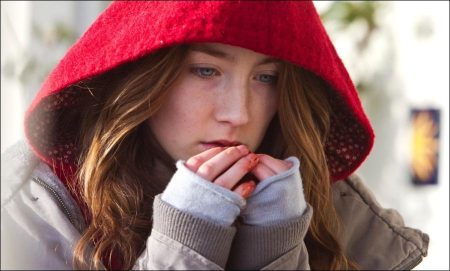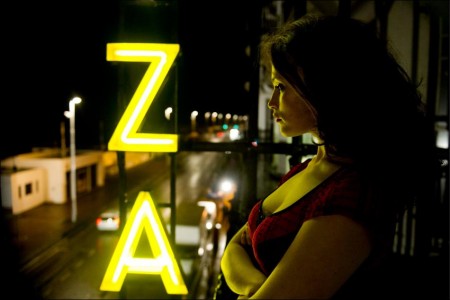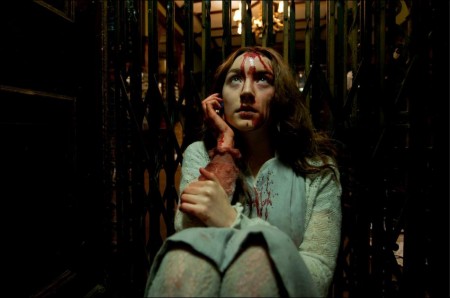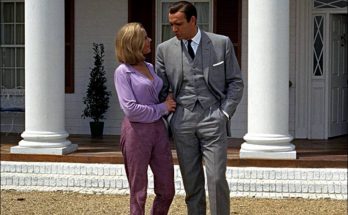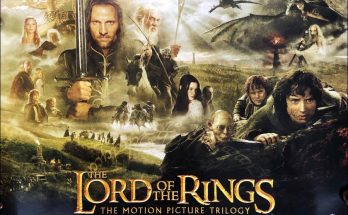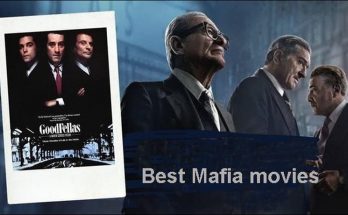Byzantium: When two mysterious women seek refuge. Eleanor and Clara, two mysterious and penniless young women, flee the scene of a violent crime and arrive in a run-down coastal resort. They try to find money and refuge along the tawdry seafront and in the dilapidated hotels.
Clara, ever-practical, sells her body. She soon meets shy and lonely Noel, who provides a roof over their heads in his seedy guesthouse, Byzantium. Clara, always looking towards the future, turns it into a ‘pop-up’ brothel.
Meanwhile Eleanor, the eternal schoolgirl, meets Frank, a kindred spirit who unwittingly prompts her to tell the truth about her life. She tells him that Clara is her mother; yet Clara is only a few years older. She says that she was born in 1804; yet she is just 16. She confesses that she must drink human blood to stay alive – and so must her mother. In the small, quiet town, people start to die. And the past that the girls have been running from for so long, finally catches up with them – with astonishing consequences.
Written by Moira Buffini and directed by Neil Jordan, Byzantium travels back and forth across the centuries as the filmmakers bring the vampire genre into the 21st century… The Film stars Gemma Arterton (Quantum of Solace, Prince of Persia, Tamara Drewe) and Saoirse Ronan (The Host, Hanna, Atonement), as well as Sam Riley (On The Road), Jonny Lee Miller (Dark Shadows, Trainspotting), Daniel Mays (Vera Drake) and Caleb Landry Jones (X-Men: First Class, The Last Exorcism).
About the Production
Moira Buffini, the playwright and screenwriter behind the adaptations of Tamara Drew and the recent Jane Eyre, had always wanted to write a vampire story.
“I was probably about eight or nine and I did that thing of creeping down and watching Christopher Lee in one of those Hammer horrors, and I was so terrified that I wouldn’t go to the loo in the night on my own for years afterwards,” she recalls. “Then vampires went from being this object of horror to this object of fascination as I grew up.”
In 2007, Buffini finally crafted her tale, ‘A Vampire Story’, aiming it at teenagers and writing it as a play. “I am quite drawn to the Gothic generally and I was reading all the early vampire stories,” continues Buffini. The John Polidori story, ‘The Vampyre’, which was huge in its day, Byron’s fragment, ‘Augustus Darvell’, and Sheridan Le Fanu’s short story, ‘Carmilla’, which is the first female vampire story, all fascinated me.”
“They are fantastic,” she adds, “and I was thinking a lot about Carmilla and a lot in general about these Gothic vampires because they are quite different from Bram Stoker. They don’t turn into dust in daylight, they don’t need coffins to sleep in, they don’t become bats, they don’t have visible fangs, they are much more invisible and they just move through society like everyone else.”
Buffini’s play came to the attention of producer Stephen Woolley. “My daughter Edith dragged me off to see a play entitled ‘A Vampire Story’,” explains Woolley who had enjoyed success in the gothic fantasy-horror realm with the likes of The Company of Wolves and Interview with the Vampire. I was consciously looking round to make another movie that was gothic and supernatural.”
At the heart of ‘A Vampire Story’, and Buffini’s screenplay for Byzantium, is a mother-daughter relationship. Here, however, they’re both vampires and are both immortal. “That was fascinating to me,” Woolley adds. “Daughters of Darkness, which was a Harry Kümel film with Delphine Seyrig, was probably one of the only vampire that have explored the tensions between older and younger female vampires.”
The vast majority of vampire stories, notes Woolley, focus on men. Women are usually the prey. “The idea of female protagonists was interesting.”
The women in the movie are Clara (Gemma Arterton) and Eleanor (Saoirse Ronan), a mother and daughter who are not that many years apart. Each was turned immortal at different stages of life, leaving a mother in her mid-20s and a daughter in her mid-teens. The central conceit of a mother-daughter vampire relationship, where they are only a few years apart in age also excited producer Elizabeth Karlsen.
“A mother’s relationship with her teenage daughter is raw with emotion of the best and worst kind,” says Karlsen. “There’s adolescent angst and loathing which competes with parental despair and longing for the innocence of youth. When the child is 16 and the mother a beautiful 24-year-old, the natural order is turned on it’s head. A fantastic, twisted and confused relationship takes its place. It is at once familiar yet totally alien.”
The title of Buffini’s original work was altered when adapting it into a screenplay, as well as changing some of the themes. “It just deepened,” she says. “Having a second go at anything always makes it better. The tone of the play was deliberately humorous in places. The tone of the film has become much darker.”
As Byzantium, the story has lengthened, too, “so you get to know the girls much better,” says the writer. “Also, the adults in the play were all monstrous, but in the film they are not. And the world on view in the film is now this marriage between a gritty, realistic, modern world and what we hope is a view of the past which doesn’t quite feel like costume drama.”
The writer goes on to say that she was a huge fan of Anne Rice’s vampire stories of the 1990s, and it perhaps comes as no surprise that when Woolley recruited a director for Byzantium he turned to a long-time collaborator, and the director of both The Company of Wolves and the Anne Rice adaptation Interview with the Vampire, Irish filmmaker Neil Jordan.
“Neil and I hadn’t worked together for about four or five years,” recalls Woolley, “After we’d made The Company of Wolves we had considered doing another Angela Carter project, which was also another female vampire film, which was based on the Carmilla story, and so that was a talking point for us. I told Neil about this project and then he rang me immediately after he had read it and said that he would love to do it.”
Karlsen adds, “For me, this is the last in the trilogy of Stephen and Neil’s work starting with The Company of Wolves and then on to Interview with the Vampire. Byzantium was so clearly a natural fit for Neil.”
Jordan has explored mythic concepts and different ideas of reality throughout his 30-year career as a writer and feature film director. “When Stephen sent me the script I couldn’t believe it,” he remembers. “It was so wonderfully complex and subtle.
“And it was strange because there were a lot of issues in there that I had dealt with in other movies. There were stories within stories, and stories about stories, and a constantly shifting narrator. It was set in a downbeat holiday town, although in England not in Ireland, this time. Also there was a reinvention of the vampire legend. I loved it.”
For producer Alan Moloney, the chance to make a vampire film with Woolley and Jordan was too good a chance to pass up. “One of the really attractive bits for me is getting to work with Stephen and Neil again,” he says. “Neil and I did Breakfast on Pluto together, which was a wonderful film. And to get to do a vampire film with the guys who made Interview with the Vampire, for me, I’m getting a bit of a kick out of that-it is quite an exiting thing to do.”
With a time frame stretching across the centuries, Jordan says that he regarded the script as “two centuries of stories. I loved that and also the fact that there was this mother and daughter pair and that their ages were so similar—they appear to be sisters. That relationship really attracted me to the film as a whole.”
He adds that Byzantium “is about two people that have to live together forever. With that framework in mind, I saw a wonderful opportunity for a reinvention of all the vampire films. I made a vampire movie before with Interview With The Vampire and since then there’s been the Twilight franchise, and the comedy vampire stuff coming up everywhere. It’s almost become child’s play. And with those kinds of films vampires have these supernatural qualities that they just develop for convenience, and thrilling storytelling. Today’s vampires can run fast and fly.
“The vampires in Byzantium are just two women that bond—because they’ve survived their cross with death. I just thought this was a great opportunity to bring vampires to life again, to make them real—because the story was rooted in realism. It actually feels like it could happen.”
When Jordan read the original draft he says that the story felt “softer than a traditional horror film”, and that the filmmakers had to decide whether it was “a mood piece, or a theatrical kind of piece or whether it should be a true horror movie.” He adds, “I tried to push them to introduce the dynamic and bloodier elements that are appropriate to the genre, and the script developed from there and became this wonderful thing.”
“It’s about people who are condemned to live forever, and it’s about vampires, obviously. They’re called something quite different in the script – they’re called soucriants — and in a way I wanted to avoid the word ‘vampire’ in the movie, because they don’t conform to any of the traditional rules of the vampire genre.
“They can go out into the sunlight, they don’t have the sharp teeth. Initially Moira had them kill people with a long thin knife, but I introduced the idea of their thumbnail growing [into a talon] when they get hungry and they use that to slit their victim’s throat. They’re different creatures from traditional vampires.”
Ultimately, Jordan says that what appealed above all was the mother and daughter relationship. “And they’re a mother and daughter who are immortals. Because they were turned into vampires at different stages of their lives they’re almost like sisters, and that confusion is great,” notes the director.
“There’s a great contradiction among the characters. Clara is full of sexuality and immediacy and violence and protectiveness and Eleanor is far more cerebral and guilt-ridden. They’re a bit like Louis and Lestat in Interview with the Vampire, in a way. The Clara-Eleanor dynamic was absolutely wonderful and it was one of those scripts that just attracts talent. Both Saoirse and Gemma loved it. They’re both wonderful actresses.”
“Clara is such a great role,” begins English actress Gemma Arterton. “It is everything I have wanted to do. You don’t tend to find scripts for women like this. Moira Buffini, the writer, is amazing. There aren’t many female screenwriters but she writes films for women.”
Arterton, of course, starred in the Buffini-scripted Tamara Drew. “Continually I read scripts where the woman is there to serve the man in some way, or to make him look better, his support. In this it is total subversion. Totally. The men are the prey, the weak ones.”
The character of Clara, we discover, was born in the 18th century and thrown into prostitution by a powerful and conniving man called Ruthven (Jonny Lee Miller). She then has a daughter, whom she abandons at an orphanage, knowing she can give her no kind of life in her low situation. A chance arrives, however, through the enigmatic character of Darvell (Sam Riley), who reveals to Ruthven that he’s found the secret of eternal life.
Darvell leaves Ruthven with a gift that reveals the source of the secret. Clara, however, steals this, steals immortality, reclaims her daughter and sets in motion the exhilarating set of events that unfold in the film.
“It has been great for me” continues Arterton. “I have done action stuff before and had to be very physical but usually there is a guy who is more physical and he gets to do all the cool stuff. But here I get to do it and I love all that — being able to be physical and committed and fearless. It is just brilliant and Clara, I feel, is such a feminist icon.”
Indeed, after suffering a life of abuse at the hands of men, Clara employs her powers to exact vengeance upon them. As an immortal she needs to feed on human blood and takes relish in destroying pimps and misogynists and other general, male, lowlife. As a mother, she is also viciously aggressive in the protection of her offspring.
“So I remember when I first read the script I thought, ‘I have just got to do it’,” beams Arterton. “I really, really wanted it because not many roles like this come up.”
While Clara seems to delight in her vengeance, things are very different for her daughter, 16-year-old Eleanor, played by Irish actress Saoirse Ronan. “Eleanor is a young girl who has been raised in an orphanage until the age of 16 and was then turned into a vampire by her mother, Gemma’s character,” explains Ronan.
“We find them at the start of the film 200 years later when their relationship has become very deep and it is just the two of them against the world. They travel from place to place and can’t really settle anywhere. They constantly have to keep moving on.”
Immortality, in the way it’s earned by Clara, Eleanor and handful of others in the story, comes at a price. The mother and daughter have to feed, they have to kill, and hence they have to murder, and move on. The film finds them set to wandering again, and they arrive in a small English seaside town, itself a relic of former glories.
“It’s interesting because you see a change in the Clara-Eleanor relationship through the film, and I think that change has been a long time coming, from my character’s point of view,” Ronan says.
“That is the difference between her and Clara. Eleanor is quite compassionate and sensitive when it comes to her prey. She chooses older people who want to go, and the ill and dying. Whereas Clara isn’t so compassionate.”
Ronan goes on to note that because “she has this dislike towards their situation, and who they are, Eleanor is constantly craving to tell the truth, but never can”.
The story is told, in part, through Eleanor’s narration. She is a keen writer, finds solace in spilling the truth about her life onto the page, but always destroys her stories, because those that read them must die.
Director Neil Jordan explains, “There’s a dynamic to horror films and a sense of terror and immediacy and things happening. We introduced more of these bloodletting elements into Moria’s first script and it really adds to the drama. Moira really leapt on that and came up with the whole theme that anyone who reads Eleanor’s story has to die. That’s an incredibly dynamic thing to work with and it’s a great plot-hanger and hook.”
Buffini says that she loved the melancholy that Eleanor’s situation provokes. “That’s the vampire’s dilemma,” she says. “It is enough to turn you melancholy. You are still human but you must feed on human blood. You don’t quite ever lose your humanity yet you are ‘other’.
“I think vampire stories are brilliant because they give us that twisted prism through which we can view humanity. I think all good vampire stories aren’t really about vampires but about us. That is why I love them.”
For Eleanor, her desire to settle down and to be accepted comes through a boy she meets in the seaside town, Frank (Caleb Landry Jones). “At the very centre of this film is this teenage love story which almost operates like every teenage love story in the world,” says Jordan. “It’s this boy, he’s shy, he’s kind of awkward, and he’s kind of an outsider. And they’re not really meant to be together at first, but they’re bound for each other.
“I just thought that was lovely. I remember saying to everyone ‘Look you’ve got to remember, there is talk about a vampire movie or a horror film, but at the centre of this film is a love story between two teenagers.’ Caleb Landry Jones did a test for me—he’s a very passionate man and he read the script for me and he did this amazing, amazing reading that just sent me over.”
Landry Jones says that the quality and honesty in the script ensured that it was unlike anything else he’d seen. “I was being sent so much typical Hollywood crap,” says Landry Jones, “and this script was everything that those other scripts were not. This was honest, and I felt Frank was an interesting character that I could do something with.”
The young actor says that in some ways he is the “audience’s way in to this world. Anyone can relate to this story and find themselves in all these characters. For me, this was a great opportunity to share the truth with someone else. I found that in the script and with Neil I had to be a part of it.
“I fell in love with Frank very quickly. I really enjoyed being him and the story is such an important one – it should reveal something about young love.”
Ronan agrees, pointing to the fact that, in a way, Eleanor and her newfound friend are both suffering similar fates. “When she meets Frank she sees another lost soul and that is why they relate so well together,” says Ronan.
Unlike Eleanor, Frank is mortal, very much so — he has a blood disease. “He is dying himself and, in a way, Eleanor is living a sort of static death,” Ronan notes. “That’s what draws her to him and she knows that she has to help him.
“The best stories are simple stories about straightforward relationships,” continues the actress. “There is a lot going on around them and at the end of the day Byzantium is a mother-daughter relationship and it is a romance as well.
“The romantic relationship that Eleanor has with Frank and how that develops and how she wins his trust — she is an outsider but he accepts her — these are all human qualities.”
Ronan, like Arterton, says she relished the fact that women take centre stage in a world more usually dominated by men. “That is always very appealing to an actress,” she says. “This story has two lead characters and they are both female and that is the first attraction, and the fact that they are the violent ones makes it more interesting.
“Here the older female lead is a very strong woman but it is not about her sexuality; it is about the strength that she has.”
That strength is tested all the way by a mysterious group of men, including Ruthven and Darvell along with Werner (Thure Lindhardt) and Savella (Uri Gavriel), men of varying degrees of corruption, who, as a collective, have not taken kindly to women trespassing on what they consider their sacred territory. The brethren are hunting Clara and her daughter down.
“The wonderful way these vampires are portrayed is that they were kind of beyond morality,” notes Jordan. “They were kind of pitiless and yet they lived. There was also elegance to them and total control. They have this wonderful quality of gentleness and mastery at the same time.”
Ruthven is determined to punish Clara. “The brethren seem to have missed out a whole section of history when women got the vote and equal pay,” says producer Stephen Woolley with a smile. “They won’t have seen Made In Dagenham and they didn’t know Emmeline Pankhurst. Their origins in the story are mysterious but there is a sense that this brotherhood really did rule the world once upon a time.”
The most intriguing, and seemingly the least iniquitous, of these men, is Darvell, played by Sam Riley. “Sam was just fantastic casting for this role because he has this kind of stillness,” says Woolley. “He also has strange depths to him as a human being and certainly he can project that as an actor.
“For us he was perfect casting because we wanted someone who comes from the past, and is in the past. We needed somebody you feel could be 200 years old, too, and Sam can project that really well.”
Karlsen agrees. “From the moment I saw Sam’s extraordinary performance in Control I have wanted to worked with him,” she says. “He has an utterly compelling physical presence and is such a fine actor. He has a troubled demeanour – both deeply emotional and chilling, which seemed perfect for the part.”
Riley describes his character: “I play an old naval Lieutenant, Darvell, who falls ill in the 1700s and is desperate to stay alive, so he starts investigating old books and ancient parchments to try and work out a way of prolonging his life. He’s heard rumours about this coven of men and is willing to sacrifice other people to continue his existence.”
It is Darvell who allows Clara to get her hands of the gift of immortality. “And women aren’t really allowed to be vampires so she’s been on the run for more than a hundred years while me and my brotherhood are coming looking for them,” Riley continues.
“Darvell has more of a conscience and he doesn’t see that there should be a particular problem with women becoming vampires. But the brotherhood are a bit like a golf club who don’t want women in there messing up their fun.” He laughs, “I suppose he’s a progressive vampire!”
The actor concludes that he found the script very unusual, as one doesn’t often see two women as the leads, “and the men playing a part in their lives, rather than the women just being a love interest or whatever. Certain subjects often become popular, and we’re not friendly vampires which seem popular at the moment!”
For the look of the vampires, make-up artist Lynn Johnston says that beyond their pale complexion and extending thumbnail (the latter a blend of CGI and prosthetics), they look pretty much like us. Only Jonny Lee Miller’s Ruthven demanded a lot of extra work.
“The Ruthven character has syphilis and starts off in 1803 looking quite healthy but then by 1810 he has a few spots and bumps and by 1820 he looks worse, with bad teeth,” she says. “For the oldest of his looks he has a bald cap with the wig, but once they become vampires they don’t change that much. They have pale faces, but that’s about it.”
The film takes inspiration for its title from two different poems by William Butler Yeats, a few lines from one, ‘Byzantium’, appearing in the film. “I think they are both two wonderful poems, which I found completely inspirational in writing the play and the film,” says Buffini, “because they are both about the quest for eternity.”
She called the last scene of her play Byzantium, “because it is a timeless place that both exists and doesn’t and it is a place for and of the imagination”. In the film Byzantium is the name of the seaside hotel in which the girls find a temporary haven. “And I loved the really earthy, material, seedy way we have used that word as the name of the hotel, bringing it down to earth with a lovely seaside tawdriness.”
Much of the film was shot in Hastings. Neil Jordan explains, “We wanted a haunted feel to a rundown seaside town. We looked at several in the Southeast of England, Margate, Hove and Brighton. But Hastings had this really haunted quality — there’s a fishing community that still works from the beach, there’s loads of closed down boarding houses, and this wonderful hotel we found that we used for the Byzantium interior. The whole place had that sense it was haunted by a past that no longer exists.”
Production designer Simon Elliott says that the Byzantium hotel almost feels like a mid-point between two worlds — between the 18th century realm in which Clara and Eleanor were born and the 21st century world in which now they exist. “It’s this weird and crazy contemporary but not quite modern kind of place,” he says. The hotel in the film is owned by a lonely young man called Noel (Daniel Mays).
“The contemporary stuff is pared down and bleak and urban and we had to make sure that the period stuff was as well,” continues Elliott. “It is not a lush grandiose environment. It was quite stark and bleak. And then sitting between the two periods is the hotel in which the girls stay, Byzantium.
“Stylistically the whole film feels urban and bleak and nothing about these girls is fancy. It is all pared down and decayed.”
The filmmakers also shot on mainland Ireland and just off the coast, as the film moves backward and forward in time. Jordan says that the 18th century sections of the film have a totally different feel from the present day. “The past we give a different photographic quality by its compositions and by the presence of grime and smoke in the atmosphere,” says the director.
Acclaimed cinematographer Sean Bobbitt is the director of photography. “Reading the script I really thought a naturalistic approach would aid the storytelling because we want to stress that these are real people, who have become vampires, and live in the world that we live in,” he says. “The lighting is heightened in places but essentially it is naturalistic. Compositionally it is very considered. We place the characters in the frame rather than the frame moving the characters around.”
Jordan concurs. “The physical beauty of the costumes and the setting, they have more of a storybook quality than the contemporary stuff,” he notes. “The latter is not cinéma vérité-style, though, with handheld cameras and found-light and grab-as-you-move photography. It’s quite rich and quite considered and the images are very strong and very decided.”
The director says that he revelled in the material and the environments in which they shot. “I love imaginary beings,” he smiles, “and imaginary creatures and worlds, and I love to set and photograph things in a situation that is apparently real but which has all this subterranean stuff going on. And this film gave me such an opportunity to do this.
“Vampires have the smell of eternity about them,” continues Jordan, “and also reflect what people miss from religion. They have this assumed elegance, too. People are attracted to vampires in the way they’re attracted to all mythology – whether they want to see a movie about a Minotaur, or Pan, or the Irish fairy tradition, it’s all the same need: a dissatisfaction with the real world.” He smiles. “People basically hate reality!”
Producer Stephen Woolley has waited almost a decade to shoot another horror film and he’s delighted with Byzantium’s look, and also its breadth of appeal.
“Anyone who likes a good old horror film will have a lot of fun with this,” he says, “and anyone who likes to think about movies will also have good fun. They might occasionally get a fright but we will keep subverting that and I think that’s what is interesting about this film.”
“Of course, there is lots and lots of horror — it is a vampire film — but there is also quite a lot of tenderness and there is a lot of beauty in terms of the relationships.”
Karlsen, meanwhile, hopes “that the audiences see what I see — a hugely original and unique piece. It is visually and emotionally poetic with two women at its centre who are together; intelligent, strident, stunning, strong and utterly, completely compelling. It is a vampire film like we have never seen before.”
The film is much darker, more frightening and more violent than some modern vampire films, says Woolley, although he believes that Twilight fans will find something in it for them.
“It’s like, ‘You used to like Twilight and now you will like this, because it will be like Twilight but real’,” he says. “It has the adolescent love affair but it is not that easy, and in fact it is skewed not towards the male character and the female victim. This has the female character and the male victim and I think it’ll feel like a strong and fresh take on the vampire movie.”
Views: 111
